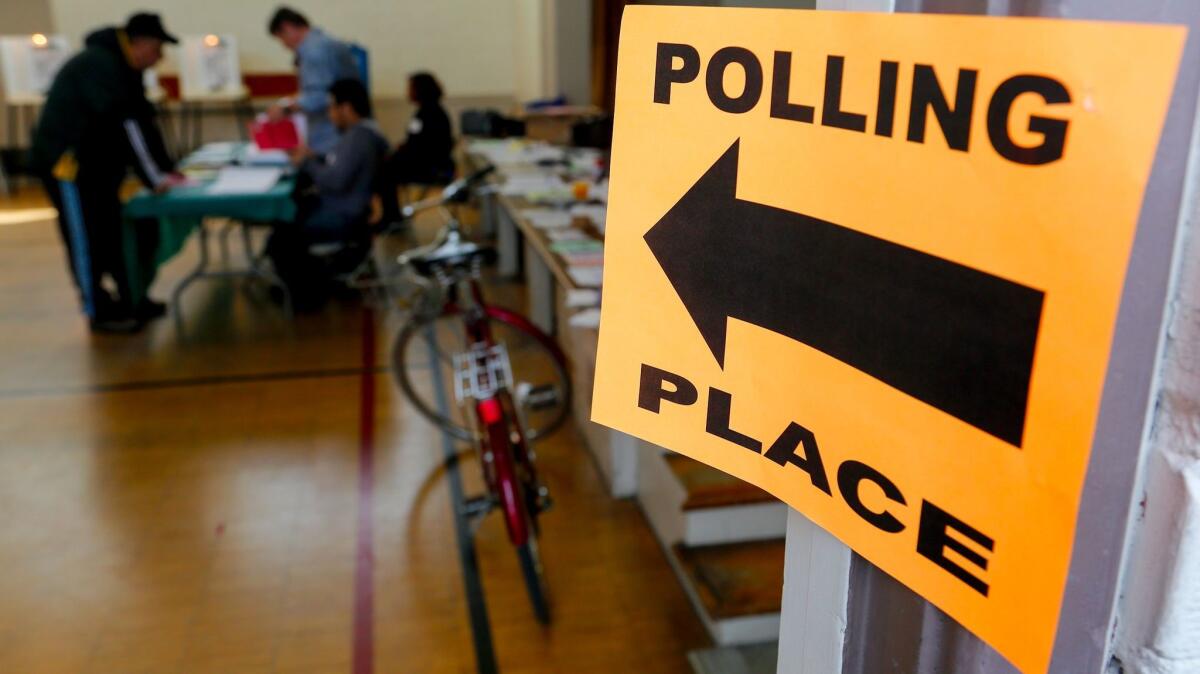Column: Political Road Map: California’s big change in voting rules is off to a rocky start for 2018

- Share via
Perhaps no part of California has thought more about the future of voting than Orange County. And yet when it comes to a sweeping change to state elections, the county has decided to take a pass.
In fact, recent events serve as a cautionary tale that changing elections is hard, even when the plan is praised by “good government” advocates as the kind of reform that will make voting fit in better with the way we live and work.
Less than two weeks ago, the Orange County Board of Supervisors quietly scrapped years of work by its elections officials on a plan to swap neighborhood polling places for universal absentee ballots and a limited number of all-purpose vote centers. There, voters could access a variety of election services — including last-minute registration, a few voting booths and a place to drop off absentee ballots. There would also be ballot drop boxes in heavily trafficked areas of the county.
The system was blessed by a state law enacted last year, allowing 14 counties — Orange included — to implement the system for 2018. The rest can do so in 2020.
The county’s registrar, Neal Kelley, has been a statewide leader of the effort. Absentee ballots are already so popular, he noted in a report to supervisors, that in a few years “more than 1,000 polling places would stand nearly empty on election day” unless the county changes its approach to voting.
In recent weeks, though, local Republicans have voiced fears of voter fraud under the new system — an unusual reaction, given it relies on the same absentee ballot process that’s been in place since the end of the Civil War. Nonetheless, Kelley’s request to move to the all-mail system was denied without discussion at the June 13 board meeting after a motion by Supervisor Todd Spitzer.
That drew a sharp rebuke from Secretary of State Alex Padilla, who suggested last week that Republican supervisors were trying to protect the GOP’s local dominance.
“I am very concerned that your action was driven less by the interests of the people of Orange County and more by political considerations,” Padilla said in a letter to the board.
Still, others haven’t exactly rushed to embrace the new law. At this point, as few as five California counties may enact the system in 2018. “Change is hard,” said Jill Lavine, the registrar of voters in Sacramento County, where supervisors signed off on it June 6. “It requires a whole new way of thinking.”
Voting rights advocates have raised questions, too. Some have pointed to research showing higher use of polling places among California’s older voters and in communities of color. Disability rights groups say some voters will lose the right to cast a secret ballot if they have to ask for help to fill it out at home.
Political Road Map: Without state funds, California counties can ignore some election laws »
Confusion is also a worry. The election law is optional — which means adjacent counties may have completely different voting systems, leaving some wondering which one applies to them. State lawmakers could have solved that by making the law mandatory, but then they would’ve had to pay for it.
Cost is an interesting part of the story, as elections officials believe switching to all-mail ballots and vote centers will be cheaper. Lavine said Sacramento County will save $4 million. “I have to get new equipment regardless,” she said — a common problem, as dozens of California counties are using outdated machines that sort and count votes.
Back in Santa Ana, Kelley was told to switch gears and buy a new traditional voting system for use in the future. That could raise the county’s costs by some $20 million.
“They set the policy, and I respect that,” Kelley said.
But registrars feel the ground shifting under their feet. They know that 58% of California voters used a mailbox last fall, not a voting booth. The state’s new election system may not be ideal, but neither is the status quo.
Follow @johnmyers on Twitter, sign up for our daily Essential Politics newsletter and listen to the weekly California Politics Podcast
ALSO:
There were serious problems in 2016 for some California voters who don’t speak English
No stamp, no problem: Californians should get postage-paid mail ballots, says lawmaker
Is it time for statewide rules in California regarding provisional ballots?
Updates on California politics and government news
More to Read
Get the L.A. Times Politics newsletter
Deeply reported insights into legislation, politics and policy from Sacramento, Washington and beyond. In your inbox three times per week.
You may occasionally receive promotional content from the Los Angeles Times.











